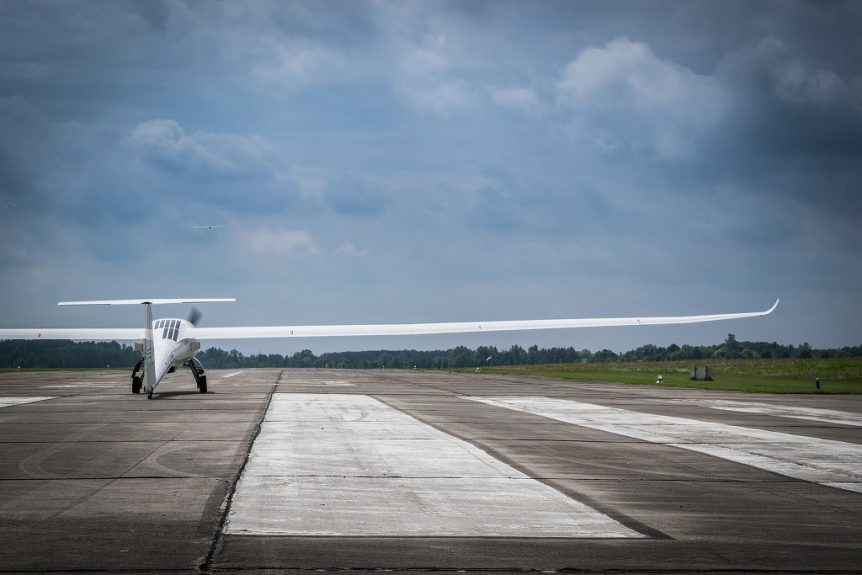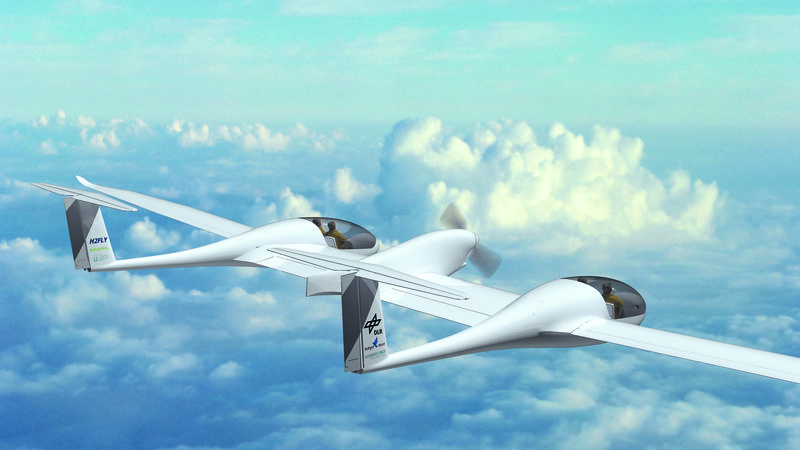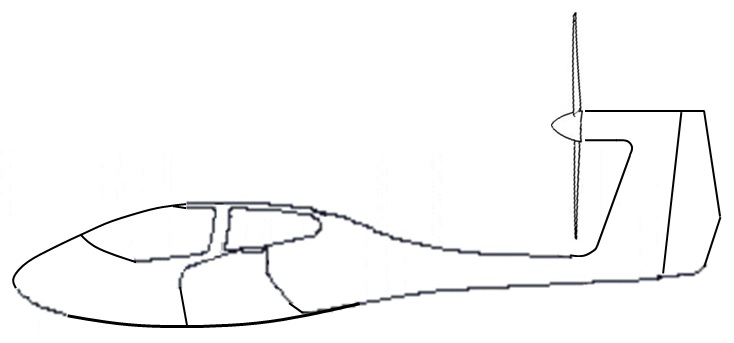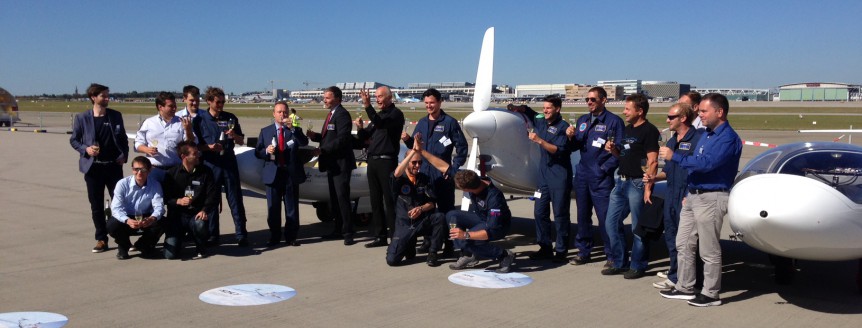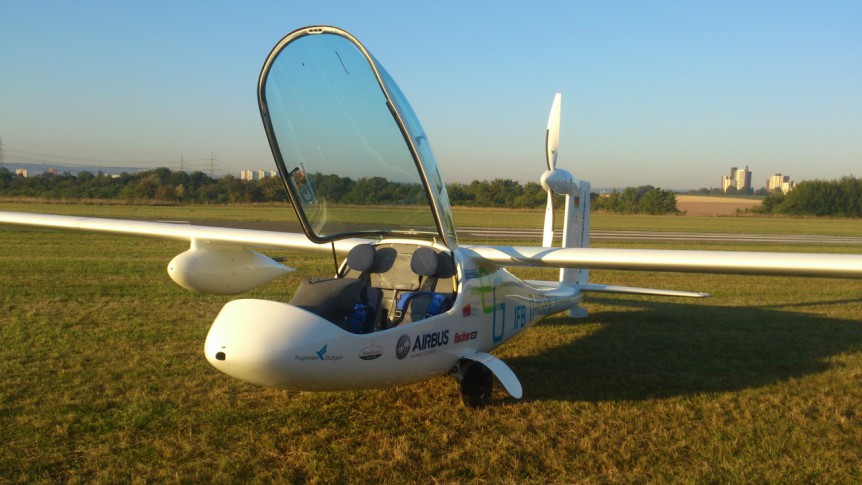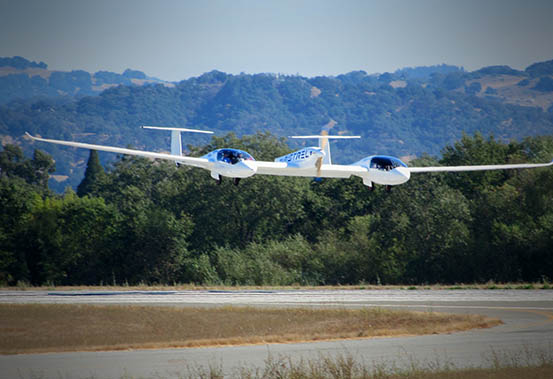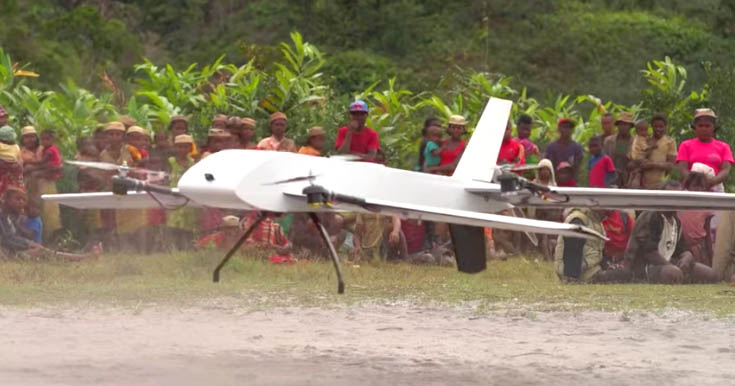One of the biggest thrills this year at Oshkosh was getting to see Eagle Flight Research Center’s DA-36 run its YASA electric motor. Eagle Flight, an outgrowth of Erik Lindbergh’s Powering Imagination program he’s been pursuing for the last several years, aims to create quiet electric aircraft that will carry sight-seers over National Parks and Monuments. Such flights would not disturb people or wildlife below, and would give a Gabriel’s eye view of the most pristine places in our country. International Approval His ideas have met with international support. As noted on the YouTube video of their meeting, “… Flavia Schlegel (Assistant Director-General (ADG) for the Natural Sciences) at UNESCO in Paris… gave an enthusiastic endorsement of our eSpirit of St. Louis electric aircraft development program!” Your editor became aware of the project when he spoke at the Powering Imagination Symposium at Seattle’s Museum of Flight in 2015. Erik told of his work with students at Embry Riddle Aeronautic University …
2017 Green Speed Cup – Airplanes More Frugal Than Priuses
The Green Speed Cup, held every year except for 2016 since 2011, is measure of an airplane’s efficiency, using a formula from the competition’s web site. “The scoring will be very simple. The aircraft that flew with the best ratio of fuel-consumption per distance and speed will win the competition. The scoring of each competitor will be related to the winner. The winner gets 1000 points for one day.” According to Robert Adam, one of the organizers of the Cup, “We had a fantastic Green Speed Cup (and rightfully but reasonably prods your editor for not covering the results sooner.) Luka Znidarsic from LZ Design won with his “front electric sustainer” Ventus glider. He had to close the gap between battery range and the given task range, but he managed with great success. In our overall statistics of the last 6 cups, he put the e-Genius quite far behind him.” Winning against e-Genius is a formidable accomplishment, since that and Pipistrel’s …
SA Symposium 2017 – An April Festival of Electric Flight
April 21 and 22, 2017, set your GPS for N 37° 31′ 20.84” W 122° 15′ 38.31” – the Hotel Pullman San Francisco Bay. The refined and beautiful setting and four-star accommodations make a grand accompaniment to the story we will share. The story of the 2017 Sustainable Aviation Symposium includes the latest in aerodynamics, electric power and energy storage. It’s a grand and sweeping review, told by talented intellects in the context of using the latest technology to help save the planet. A few exemplars of the program highlight this year’s story, “ A Keynote Address from a Master Designer Tine Tomazic, Director of Research and Development for Pipistrel, created the G4 to win the 2011 Green Flight Challenge, the Alpha Electro Trainer, and the Hypstair hybrid speedster. His pioneering forays into electric power have made him a leader in development of everything from airframes to instrumentation. What will he come up with next? He might share that at …
EC04 Design Wins 2016 Berblinger Prize
A Big Win for Stuttgart Team Dipl-Ing Ingmar Geiß, Deputy Project Leader for e-Genius at the Institute of Aircraft Design at the University of Stuttgart, shared this pleasant news: “I am happy to tell you that our hybrid-electric “ECO4” has won the Berblinger Prize 2016. ECO4 combines an optimized electric airframe with a modern combustion engine generating electricity. This combination leads to an aircraft which cruises at 120 knots and consumes 40 percent less fuel than comparable state-of-the-art airplanes with conventional propulsion. As a further advantage, a small but powerful battery system enables a silent take-off without the combustion engine running, reducing significantly the noise emissions.” The Berblinger Prize Gunter Czisch, mayor of Ulm, presented the 23,000 euro ($24,035 US) prize to the team, which intends to invest the amount “directly into the further development of the airplane.” The prize was founded in recognition of Albrecht Ludwig Berblinger, “the little tailor of Ulm, who tried to cross the river …
Pipistrel, Sino GA Sign Memorandum of Agreement
China has over one billion, four hundred million people. Slovenia has a little over two million. This population disparity has not kept Pipistrel d.o.o. Ajdovscina and Chinese company Sino GA Group Co. from signing a Memorandum of Understanding for a long-term joint-venture in the field of light and general aviation in the regions of China, East Asian countries and the Asian Pacific region. Pipistrel, led by General Manager Ivo Boscarol, has built many airplanes in its 27-year history (including over 800 of its Sinus/Virus series), and earned plaudits for its clean manufacturing and ethical management. It has led in development of electric motorgliders, an electric training aircraft, and a high-performance hybrid cruiser. It won the Green Flight Challenge in 2011 with a battery powered aircraft that managed to cruise at over 100 mph for 200 miles and returned 403.5 passenger miles per gallon. That airframe has been converted to hydrogen power and was flown in September in a 10-minute demonstration …
HY4 Makes First Public Flight – Your Editor Rides EAA’s Ford Trimotor
A day after Pipistrel, the DLR and associates flew the first public demonstration of their four-seat hydrogen-powered HY4, your editor and a friend took a brief hop around the Aurora State Airport in Oregon in EAA’s Ford Trimotor, the first certified airliner in America. The two events, roughly equal in duration, if not in historicity, demonstrate a readily observable progress in aeronautics. A quickening of design and technology 14 years after the Ford 5AT first flew on a scheduled route that took 51 hours total time to cross the United States (and split transport duties with trains), your editor’s father was whisked nonstop by Army Air Corps C-54 across the Atlantic to Shannon, Ireland, and then to Bobbington and Newquay, England to work on bombers for the duration of the conflict. Those 14 years seem like a major quickening of design and technology, which brought us pressurized cockpits, turbocharged engines, and great leaps forward in speed, endurance and reliability. Following the …
e-Genius Flies with a Range Extender
Stuttgart to Barcelona Dipl-Ing* Ingmar Geiß, Deputy Project Manager for e-Genius with the Institute of aeronautical engineering at Stuttgart University shared the news that e-Genius flew with its range extender for the first time on September 15. He notes that while the battery-powered airplane can manage trips up to 300 kilometers (186 miles), the hybrid engine/generator pod will enable flights up to 1,000 kilometers (620 miles). This would equal a trip from Stuttgart to Barcelona, Spain, according to the e-Genius web site. As the school explains, “With [the] e-Genius hybrid most flights of a typical user case can be done in the cost and energy efficient battery mode – for all longer flights the range extender can be used. Generator system control requires no pilot input, everything being done automatically. If the pilot wants to set down at the end of a trip with a certain amount of battery energy on board, e-Genius has an ingenious “look-ahead” feature to modulate …
Dr. Joseph Kallo, DLR See a Hydrogen Future
Speaking at the first annual Sustainable Aviation Symposium at the Sofitel San Francisco Bay on May 6, 2016. Dr. Joseph Kallo focused on hydrogen as a more than potential fuel for future flight. He stressed that H2 fuel development was further along than one would think, and shared several examples to promote that thought. A Busy Man, a Storied Airframe Dr. Kallo is DLR (Deutsches Zentrum für Luft-und Raumfahrt – German Center for Air and SpaceTravel) Coordinator of Electrical Aviation for Germany’s equivalent of NASA, oversees work at the DLR Institute of Engineering Thermodynamics, which has worked with Pipistrel in Slovenia to convert the Green Flight Prize winning Pipistrel G4 to the hydrogen-powered HY4. He’s also Institute Director at the Institute of Energy Conversion and Storage, Ulm University. That group provides expertise on hybridization for the HY4 project. Ulm partners with aircraft designer Pipistrel, fuel cell provider Hydrogenics, and DLR to make the aircraft a reality. H2Fly will operate the …
Madagascar Medicine Meets the Green Flight Challenge
In the Small World category, the team leader of the 2011 Green Flight Challenge winning team is designing the next generation of a drone that can carry blood and stool samples from remote and otherwise inaccessible parts of Madagascar to a central laboratory where the samples can be analyzed. Jack Langelaan, Professor of Aerospace Engineering at Pennsylvania State University, is working with Vayu Aircraft to develop a vertical takeoff and landing machine specially crafted to meet the needs of the ValBio Centre. The video shows an early version of the drone, while pictures on Vayu’s web site depict a sleeker, more refined approach. The functionality for both machines would seem to be identical, but the styling for the projected future version is far more “marketable.” Dr. Peter Small, Founding Director of Stony Brook’s Global Health Institute, sees the flights as a win-win for drones and villagers. “The flights to and from villages in the Ifanadiana district [of Madagascar] ushers in …
NASA Tests Pipistrel Systems To Aid Electric X-plane Program
Taja Boscarol of Pipistrel in Slovenia relays the information that NASA has tested Pipistrel’s electric propulsion system as part of its electric flight research for the X-57 program. It would seem reasonable to start by checking out Pipistrel’s well-tested motor package, one of the few that comes with fully-matched controller, batteries, and ancillary gear. NASA performed its tests on its 13.5-foot Airvolt stand at the Armstrong Flight Research Center at Edwards Air Force Base, California. Heavily instrumented, the Airvolt stand collects data through “high-fidelity sensors,” and transmits the collected information to a data acquisition unit that processes, records, and filters the measurements. NASA and Pipistrel should be able to make good use of this data. Normally installed on the Taurus Electro G2 motorglider, the Roman Susnik designed motor produces 40 kilowatts (53.6 hp.) at low rpm while producing high torque, an ideal combination for rapid climbs to soaring altitude. NASA will collect “torque and thrust measurements, high-fidelity voltage analysis, power …


